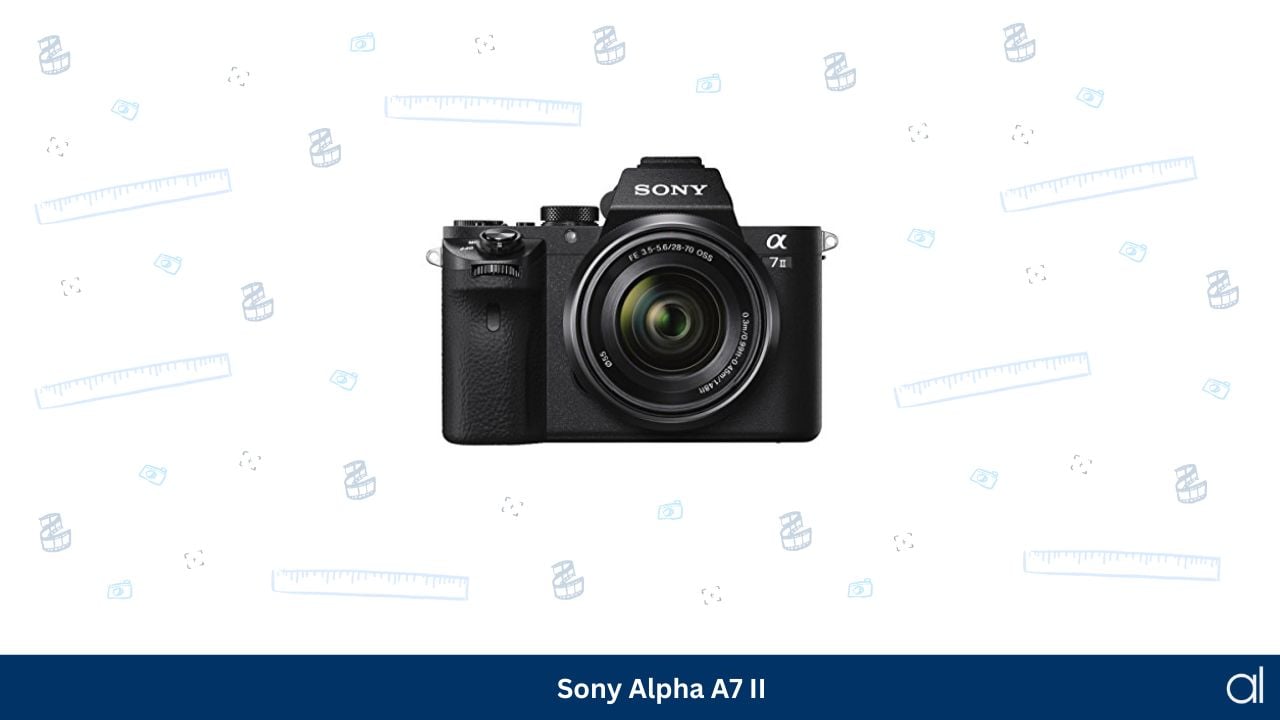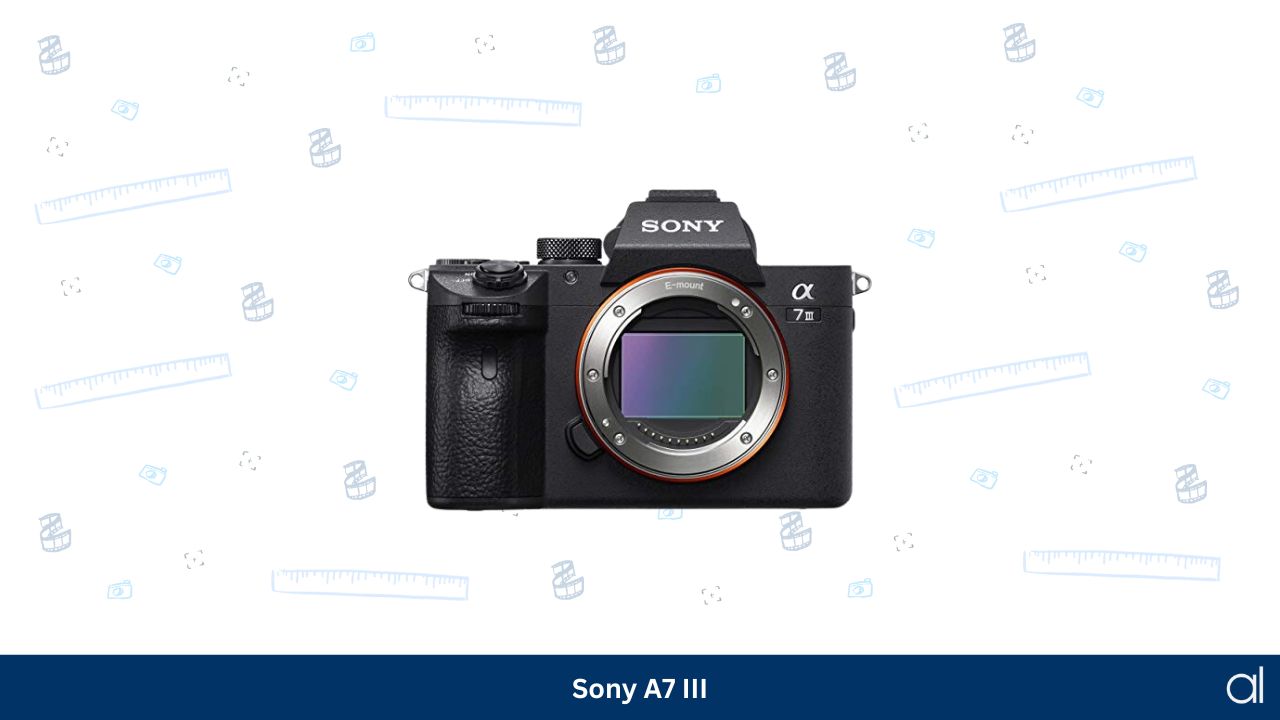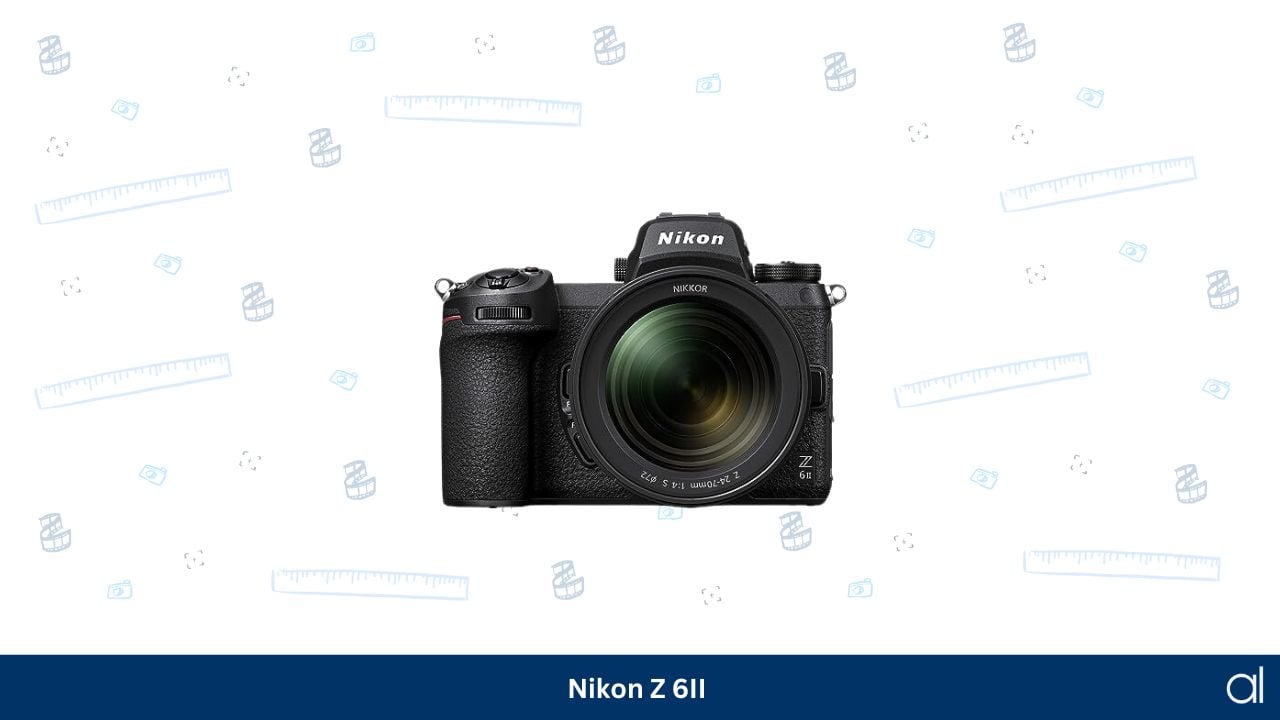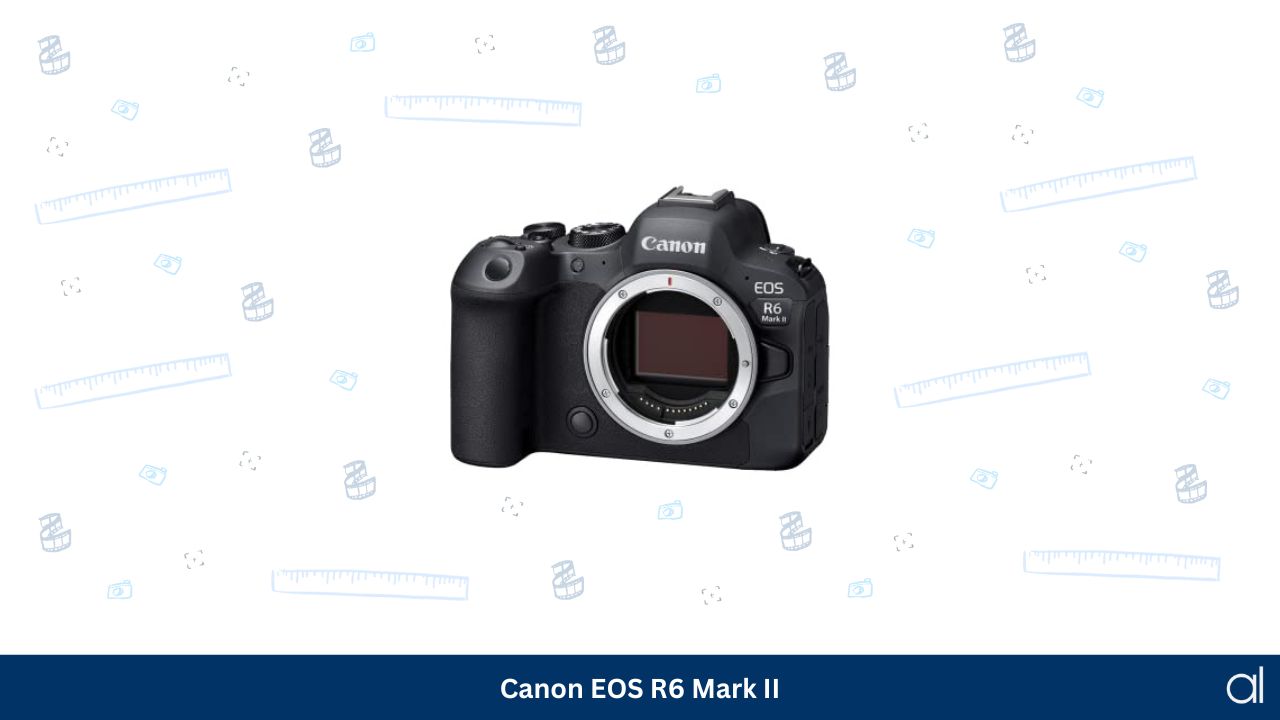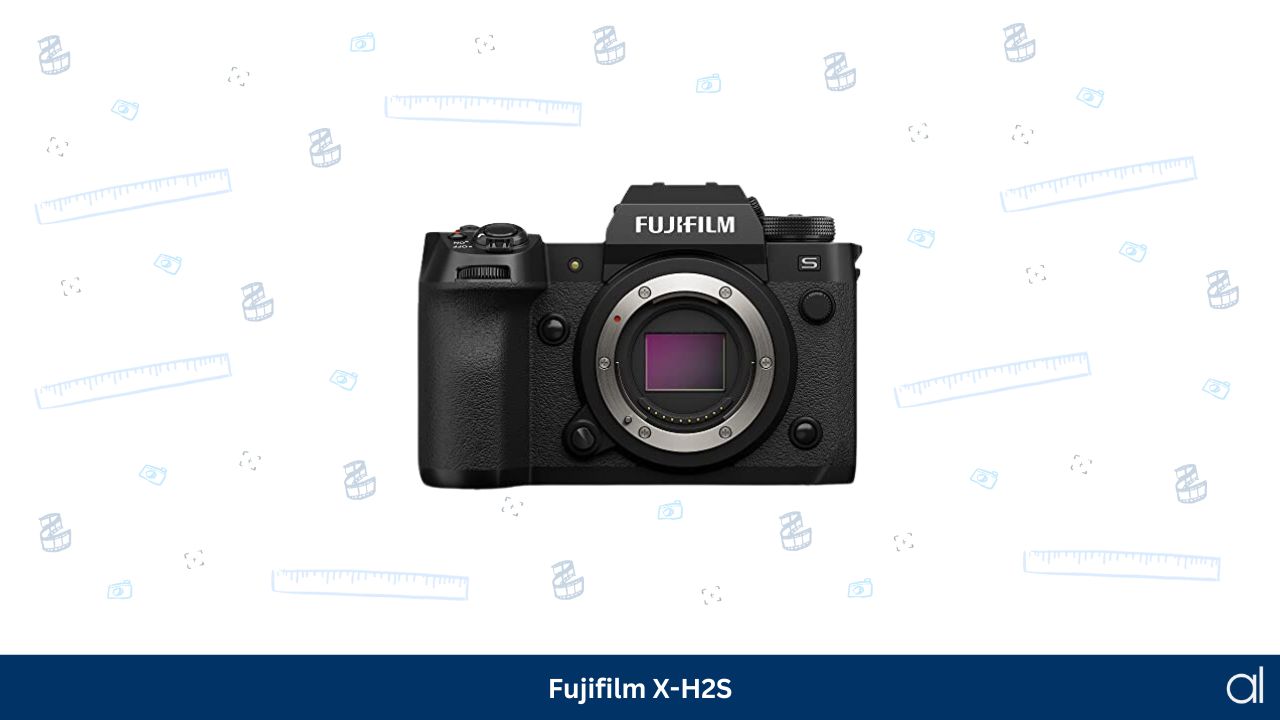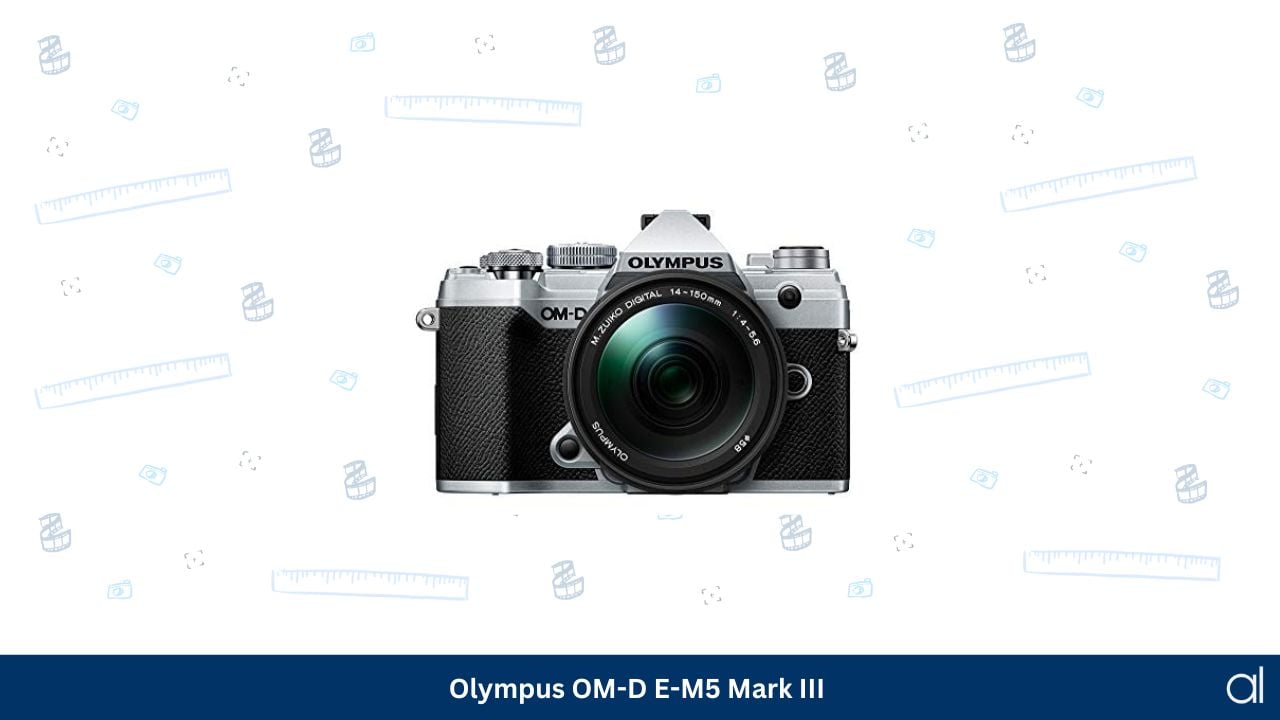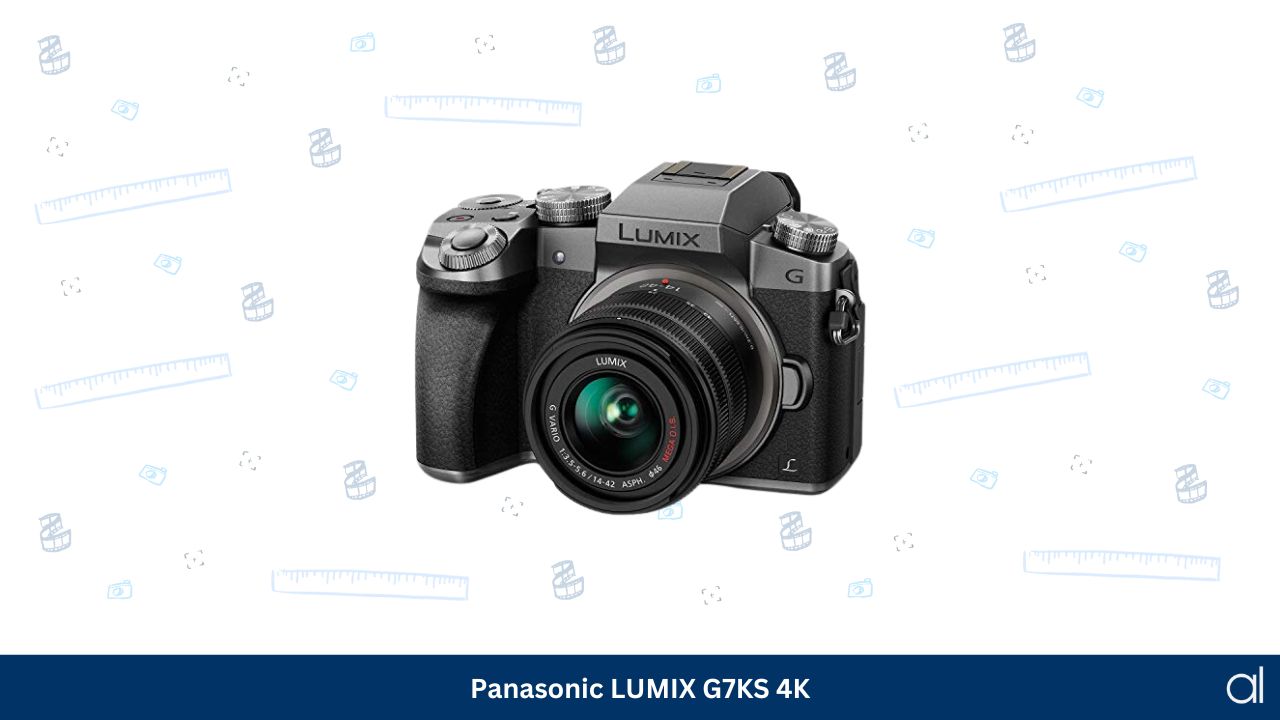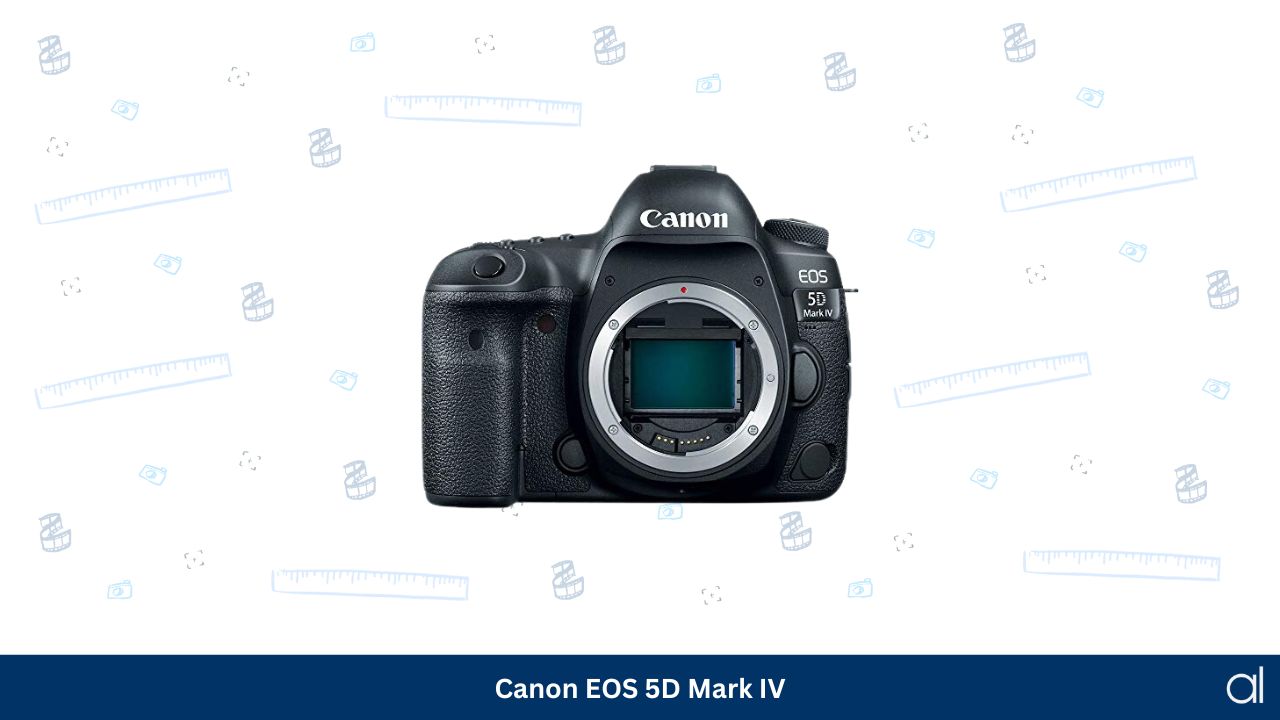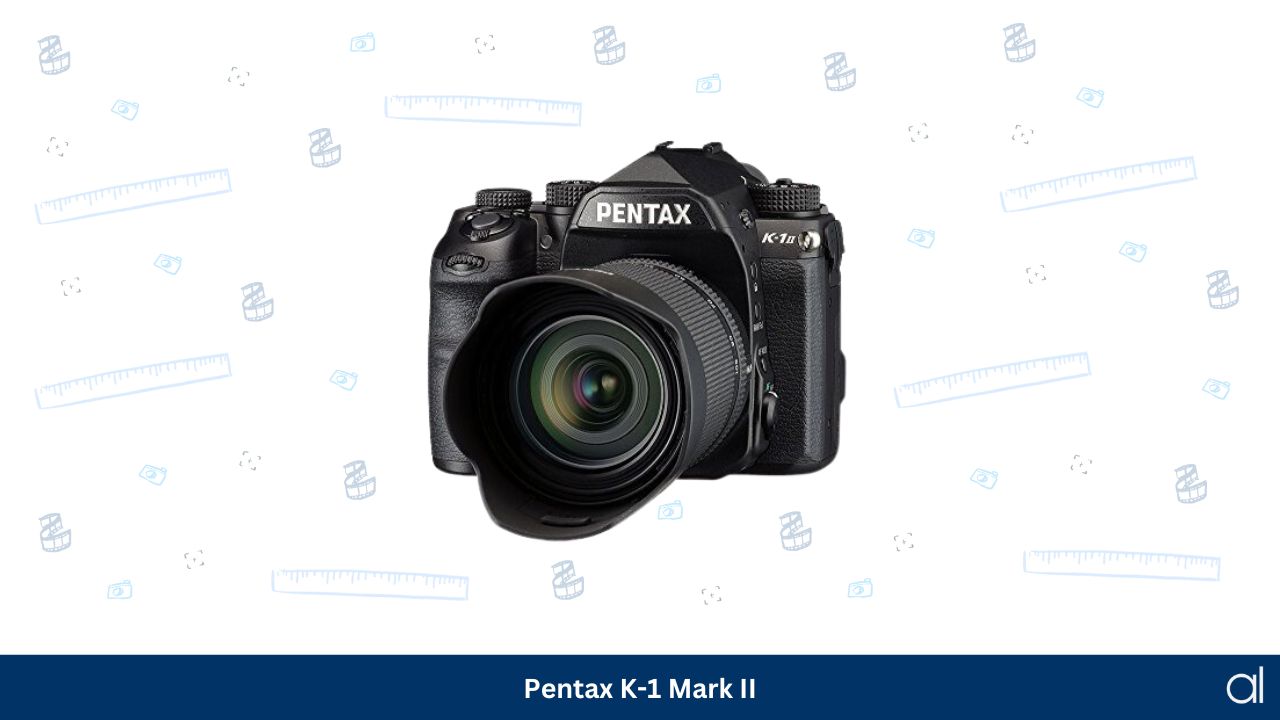Architectural photography can be a beautiful profession or hobby to have. Capturing the intrinsic beauty of a structure through your camera lens takes time and effort.
But choosing the right camera for that can be quite confusing. If you’re confused about which is the best camera as well, I’m here to help you out.
Read ahead for the best 9 cameras available for architectural photographers in 2023.
9 Best Cameras For Architectural Photography
1. Sony Alpha A7 II – Best With In-Body Image Stabilization
The Sony Alpha A7 II is the best camera that I tried out, for both professional and amateur architectural photography.
Being the world’s first 5-axis in body image stabilization unit in a full body camera, you can capture stunning photographs with the full frame camera. And, drawing from experience, you don’t even have to worry about your precious photos getting ruined or blurred due to camera shake.
With a 24.3 MP resolution, super-fast autofocus, and a compact design, this camera will allow for shake-free and brilliant images. Moreover, the E-mount lens system is particularly well-suited for video shooting, with the model containing “movie-friendly features” like smooth focusing, powered zoom control, and silent iris/ aperture control.
The camera offers excellent connectivity with mobile devices. In addition to WiFi support for connecting to smartphones, this camera supports NFC (near-field communication), providing a one-touch connection feature when transferring images to an Android smartphone or tablet.
All you need to do is touch the devices to connect.
What I Liked
- Excellent value for money
- Blur-free images
- Easy connectivity
- Tilt shift lens
What I Didn’t Like
2. Sony A7 III Full-Frame Mirrorless Camera – Best Mirrorless Camera
Back with this series, the Sony A7 III camera is one of the best mirrorless cameras you will find for architectural photography. The 5-axis steadyshot with stabilization and the high ISO 204800 setting with ten FPS (frames per second) steady shooting all contribute to making it such a great camera.
Based on my first-hand experience, this camera will provide realistic detail in your photographs, thanks to the BIONZ processor X for high resolution. The new version of the 24.2 MP5 Exmor R CMOS sensor features a back-illuminated structure.
And lastly, the Detail Reproduction and Area-specific noise reduction technologies will help to maintain the best image details and reduce noise.
What I Liked
- Weatherproof body
- 4K UHD at 30p video recording
- BIONZ processor
- Highly realistic details
What I Didn’t Like
3. Nikon Z 6II Full Frame Mirrorless Digital Camera – Best For Low Light Photography
The Nikon Z6 II mirrorless camera is another good option when it comes to architectural photography. Its 24.5 MP BSI resolution excels in low light, so hello night-time architecture photography!
This camera’s 14 FPS and 4K UHD video performance make it the best for fast-action shooting. Moreover, the advanced and clear viewfinder has minimal blackout during high-speed shooting.
The Expeed 6 helps with noise reduction with an exceptionally high ISO setting of up to 51,200. After seeing it in action, the 273-point Hybrid AF system helps the image to be extremely realistic and stunning. Its 90% frame coverage allows you to compose your also photographs the way you want.
Its wide-angle lens is great for busy scenes and large architectural models. Plus, the dual card slots mean you don’t have to worry about running out of memory while you’re shooting photographs of architectural beauty.
What I Liked
- 5-axis vibration reduction
- Sloping touchscreen LCD screen
- CFExpree and XQD card slots
- Low light photography
What I Didn’t Like
4. Canon EOS R6 Mark II Full Frame Mirrorless Camera – Best For Dynamic Range
Even though this Canon EOS camera might be a little out-of-the-budget for some people, it is a great option for architecture photography. The full-frame sensor with 24.2 MP will allow you to capture sharp and detailed images, even in low light conditions.
Its 45-point All-cross type AF system helps you can capture images with a high degree of realistic detail. Moving ahead, the autofocus doesn’t leave much to be desired. The highly responsive Dual Pixel CMOS AF II system will cover approximately 100% of the frame area, which leads to outstanding AF coverage.
Also, the DIGIC X image processor enhances the performance of this Canon camera, including image stabilization, image processing, and video functionality. This allows for sharp and high-resolution images with minimal noise or grain.
My hands-on experience revealed that the electronic shutter speed of 40 FPS at 20 MP allows you to capture all sorts of architectural images in a wide dynamic range. Additionally, the optimized video recording means you can keep the cameras rolling for up to 6 hours of continuous FULL HD video recording.
This means you can capture full movies without worrying about overheating at high resolution.
What I Liked
- Great for video shooting
- Outstanding AF coverage
- Innate ISO 40000
- 45-Point All-Cross Type AF System
What I Didn’t Like
5. Fujifilm X-H2S Mirrorless Camera – Best With X-Trans Color Filter
The Fujifilm X-H2S has a 26.1 MP and X-Trans 5 stacked back-illuminated sensor, which make for excellent architectural photography. Its unique X-trans color filter array minimizes moire and false colors, while the camera provides high low light performance and 14-stops of dynamic range.
I noticed the autofocus in this camera is not only quick but also highly advanced. Continuous shooting is possible at 15 FPS with the mechanical shutter, and up to 40 FPS when the electrical shutter is deployed.
These speeds are backed up by the camera’s high-capacity buffer, which allows for unlimited recording and writing of JPEG and RAW image format to a high-speed memory card when using the mechanical shutter. Additionally, the 5-axis in-body stabilization system offers up to seven stops of shake reduction to provide the handheld user with true versatility.
What I Liked
- Continuous recording without overheating
- Good performance in low lighting
- High-speed burst shooting
- Image stabilization
What I Didn’t Like
6. Olympus OM-D E-M5 Mark III Camera – Best With Live Composite Mode
The Olympus OM-D E-M5 Mark III is a compact, lightweight, and comfortable camera. Features like 30 FPS sequential shooting, 121-Point All-Cross type phase and contrast detection AF, 5-axis in-body stabilization, and 50 MP high resolution all contribute to making this camera a great option for architecture photographers.
As I tested it, I found that this camera is great for long-exposure photography. Using the Live Composite Mode, capturing nighttime cityscapes and perfect starry nights becomes easy.
Moreover, you can travel with this camera without worrying about any damage being caused by natural elements, as the camera is dustproof, splashproof, and freezeproof. No extra protective gear is required, while the 14 – 150mm lens itself comes with a weather-proof body.
You can even get a video capture resolution of 4K UHD 2160p and 2K DCI 1080p with this portable camera.
What I Liked
- Compact and lightweight
- Weatherproof body
- Live Composite Mode
- Highly portable
What I Didn’t Like
7. Panasonic LUMIX G7KS 4K Mirrorless Camera – Best With OLED Viewfinder
If you are tired of the bulky weight of DSLRs and want something cheaper and lightweight, then the Panasonic Lumix G7KS mirrorless camera is a great option for architectural photography. You can get excellent DSLM picture quality with this camera without a huge load of DSLR cameras.
Even though the camera is lighter than traditional cameras, the camera still provides intuitive controls with easy access. You can easily control the aperture and the shutter settings with the front and rear dials.
Additionally, the high-resolution OLED viewfinder with 10000:1 contrast allows for high visibility, even under direct sunlight. Plus, the tilt/swivel touch-display adjusts for optimum clarity. The 4EV low light autofocus will let you clearly capture your architectural subjects even under poor light conditions.
Moreover, giving it a try showed that the 16 MP sensor features an intelligent image processor that produces videos and images free from artifacts that degrade image quality.
Lastly, you can always expand the functionality of the camera with optional accessories like the DMW-FL580L external flash and DMW-MS2 stereo and shotgun microphone.
What I Liked
- No shutter noise
- Easy and intuitive controls
- Affordable
- High speed autofocus with DFD technology
What I Didn’t Like
8. Canon EOS 5D Mark IV Full Frame DSLR – Best With Full-Frame CMOS Sensor
The Canon EOS 5D Mark IV comes with a 30.4 MP full-frame CMOS sensor, that allows for versatile shooting in nearly any light. It has an ISO range of 100 – 32000, which is expandable up to 50 – 102400.
This Canon EOS camera features an AF sensor with 61 AF points and up to 41 cross-type AF points to deliver excellent image quality, accuracy, and performance. The dedicated RGB+IR light sensor with an approximately 150,000-pixel resolution quickly determines and maintains proper exposure.
Additionally, the excellent dual-pixel CMOS AF allows for smooth and responsive AF during video or live-view shooting. Additionally, the LCD monitor has a full touchscreen interface, including a selection of the AF area.
Moreover, based on my observations, the DIGIC 6+ processor allows up to 7 FPS of continuous shooting speed with excellent picture quality at the same time.
What I Liked
- Good low light performance
- 7 FPS of continuous shooting
- Easy-to-navigate touchscreen LCD panel
- Dual CMOS system
What I Didn’t Like
9. Pentax K-1 Mark II Full Frame Digital Camera – Best For Dust Removal Mechanism
Lastly, we come to the Pentax K-1 Mark II full-frame digital camera. The camera offers high-resolution images with 36.4 effective megapixels. This will ensure that the architectural details won’t go amiss in your photographs and the images will come out with outstanding detail.
The optical viewfinder has a nearly 100% field of view, which assures a clear view of the subject and ease of focus. I have found from using this product that the Dust Removal II mechanism effectively removes all dust particles from the image sensor surface, and prevents any unwanted spots from appearing on the captured image. Additionally, the camera itself is made out of dust-proof and weather-resistant construction.
Moreover, the top sensitivity of the ISO 819200 and the great image processing system both allow for good quality pictures with reduced noise and grain.
However, the camera is quite heavy compared to the rest of the options on this list and the battery life is quite poor. But that is to be expected with any DSLR camera.
What I Liked
- Excellent optical viewfinder
- ISO 819200
- Weather-resistant construction
- Dust removal mechanism
What I Didn’t Like
Top Cameras For Architectural Photography Comparison Table
| Top Cameras | Effective Still Resolution | Connectivity | Screen Size | Item Weight |
|---|---|---|---|---|
| Sony Alpha A7 II | 24.3 | USB, HDMI, NFC, Wi-Fi | 3 inches | 1.32 lbs |
| Sony A7 III Full-Frame Mirrorless Camera | 24.2 | HDMI, NFC | 3 inches | 1.44 lbs |
| Nikon Z 6II Full Frame Mirrorless Digital Camera | 24.5 | Bluetooth, WiFi, HDMI, GPS, USB | 3.2 inches | 2.46 lbs |
| Canon EOS R6 Mark II Full Frame Mirrorless Camera | 24.2 | Bluetooth, WiFi, USB | 3 inches | 2.75 lbs |
| Fujifilm X-H2S Mirrorless Camera | 26.16 | USB, HDMI | 3 inches | 1.45 lbs |
| Olympus OM-D E-M5 Mark III Camera | 20 | Bluetooth, WiFi, Micro HDMI, USB | 3 inches | 3.5 lbs |
| Panasonic LUMIX G7KS 4K Mirrorless Camera | 16 | WiFi, HDMI | 3 inches | 0.9 lbs |
| Canon EOS 5D Mark IV Full Frame DSLR | 30.4 | HDMI, WiFi | 3.2 inches | 2.73 lbs |
| Pentax K-1 Mark II Full Frame Digital Camera | 36 | USB, HDMI | 3.2 inches | 5.0 lbs |
Buying Guide For the Best Cameras For Architectural Photography
So much thought and creativity goes into making architectural structures and buildings. And capturing that creativity and thoughtfulness through the lens of your camera takes not only practice but also a lot of patience. Many people also prefer to use drones to get the best view of a building.
Other than those factors, the most important part of architectural photography is a good quality camera. You can always improve your photography results with the help of a good camera. But choosing the right camera for architecture photography can be quite confusing, what with all the camera features and specifications, especially for a beginner or an amateur photographer. But don’t you worry, I’ve got you covered!
Here is a buyer’s guide detailing all the factors that you should look into before you go and spend a thousand bucks on the first camera you see. These features will help to refine and improve your work and produce high image quality. So, let’s get into it.
1. Type Of Camera
There are basically three types of cameras to choose from for architecture photography: compact, mirrorless, and DSLRs. Mirrorless and DSLR cameras are interchangeable lens cameras. Obviously, that helps to improve the versatility and range of your photography. You can capture a myriad of things and capture them differently each time too.
Compact cameras, on the other hand, have a fixed lens which obviously limits your range. But they are more lightweight and affordable compared to mirrorless and DSLR cameras. So, ease-of-use and affordability is a priority for you, you can always pick a compact camera over mirrorless and DSLRs.
Mirrorless and DSLR cameras themselves can be quite different. A mirrorless camera is generally more advanced in terms of technology and autofocus. But many photographers still prefer DSLR due to its proven excellence. At the end of the day, it comes down to personal preference.
You can also choose between full frame sensor cameras and crop sensor cameras, where the main difference is the size.
2. Image Stabilization System
The image stabilization system is something that will prevent handheld users from getting blurry images due to camera shakes. Of course, you can always carry around a tripod for photography and use that to make the camera stable.
However, image stabilization becomes important if you are a fan of night time photography, low light photography, handheld photography, or long lenses. So, if you are into any of that, you might want to look into the features of image stabilization of the camera.
3. Autofocus
As you might have noticed, most of the mirrorless cameras on this list had an excellent autofocus system. And even though that drives up the price of the camera, most professional photographers prefer an exceptional autofocus system due to its high accuracy and speed.
However, if you are just an amateur photographer or a hobbyist, you really don’t need an obscenely expensive autofocus system. This becomes even more true when it comes to architectural photography, since that mostly involves shooting still and static images. Still, landscapes, portraits, and macros don’t really need an expensive autofocus system.
Of course, if you are going to be shooting videos or dynamic subjects, then the need for a good autofocus system arises.
4. Image Resolution
Resolution becomes a concern depending on what you intend to do with your photographs. If you print your images in big sizes, then that means the photograph requires a higher degree of detailing. In that case, the high pixels make sense. Even apart from that, if you just prefer your images to have fine details, a high resolution is a must.
On the other hand, if you intend to keep your images in the form of a small-sized file in your system or print them out in small sizes, then a low resolution camera will also make do. Obviously, that also means that you’ll be saving up on quite a few dollars.
5. Frame Rate
The frame rate is another factor that depends on whether you are going to be recording videos/ dynamic objects or still and static objects. For shooting static objects, you obviously don’t need a ridiculous frame rate specification. For instance, a 20 FPS frame rate is unnecessary for shooting static objects. And since architectural photography mainly consists of still objects (obviously), you can always opt for a camera with a low frame rate if you’re on a budget.
On the other hand, if you are going to be shooting videos or dynamic subjects, you need to have a higher frame rate.
6. Viewfinder
Viewfinders can be of two types: electronic and optical. Most of the cameras on this list are mirrorless and thus, feature an electronic viewfinder. Check out the resolution of the electronic viewfinder before you get. Obviously, the higher the resolution, the more expensive the camera will be. Electronic viewfinders help to simulate exposure and give creative previews.
Most DSLRs, on the other hand, feature optical viewfinders. Optical viewfinders give the real scene and are great under low light conditions. However, they suffer from a phenomenon known as viewfinder blackout, which means that you can’t see the image when you click the shutter.
In the end, it all depends on your personal preference. Both viewfinders have their own advantages and limitations. Depending on your photography needs, you should choose the optimal viewfinder for yourself.
7. Screen
Lastly, we come to the screen. For the screen, you need to look out for the size, the resolution, and its tilting capabilities. A screen that offers to tilt is great for when you need to photograph from odd angles. Other than that, it is a feature about which you don’t need to think much.
What are some additional photography accessories that I need?
Of course, you don’t need anything other than a camera to click photographs. But there’s nothing wrong with having a few extra accessories to help you out while you’re clicking photos.
A few of the additional photography accessories are; A tripod stand, L-Bracket and Panorama Head, Lens head, Filters- Polarizers, Graduated, and Neutral Density filters, and Light meters to control exposure.
What are some tips for great architectural photography?
Apart from the obvious skill and professionalism required for architectural photography, here are some additional tips so that you can get the best architectural photograph of your life:
1. Know Your Surroundings: You should be aware of your surroundings when you’re trying to capture something. Surroundings include weather and the positioning of the sun since both of those factors can affect how your final image looks. You can always carry a continuous lighting kit around to control the amount of light in your photographs.
2. Check For Reflections: After you have chosen the right architectural model and the right spot to photograph it from, the next step is to check for any annoying reflections that you might catch.
3. Portrayal: You should know how you want to portray the image. Do you want it to look more artistic or more stoic? Do you want it in portrait style or landscape style? All of this will help in deciding the final results of your photography.
4. Patience: Taking the perfect photo can be very time-consuming. Very, very time-consuming sometimes. But patience is the key. You need to keep trying till you get that perfect shot.
What are the best camera settings for architectural photography?
Architectural photography is all about the details. So, according to that, here are the best camera settings to get the best photos: Narrow aperture, like f/11, Low ISO, such as ISO 100 or ISO 200, Manual exposure mode, and AF – one shot.
What are tilt shift lenses?
Tilt-shift lenses are where the optics can be shifted or tilted concerning the image sensor. They rotate to allow the lens to shift in many different directions.
Conclusion
Drumroll, please – it’s time for the final verdict. In the first position is the Sony A7 II camera with its exceptional stabilization system, affordability, and tiltable screen. The camera offers very easy connectivity and has a ton of movie-friendly features in case you want to shoot videos.
In second place is Sony again: the Sony A7 III camera. It’s excellent detailing, noise reduction, and powerful processor definitely make it a worthy investment. And finally, in third place is the Nikon Z6 camera with its clear viewfinder, high ISO settings, and exceptional performance in low light conditions.
Hopefully, this article will help you find the best camera to fulfill your architectural photography needs. You can also do more research and go through the buyer’s guide when reviewing other options not mentioned here.
Related Articles
Simply the Best Drones for Architectural Photography
4 of the Best Large Format Printers for Photographers
7 Best Tripods for Macro Photography
The 10 Best Cameras for Photographing Artwork
5 of the Best Tripods for Real Estate Architectural Photography

